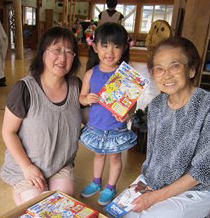Summertime in Japan is a time for local festivals, many of which have traditions that date back centuries.There were doubts as to whether some of these festivals would be held in light of the tragic events. One of the region’s most colorful events, for example, the Soma Wild Horse Chase Festival (Nomaoi), which dates back to 10th century samurai military training, had to be scaled back in light of the proximity of the towns of Soma and Minamisoma to the Fukushima nuclear plant, but the organizers felt it was important to hold the festival as a way of encouraging the community. For similar reasons, Peace Winds Japan (PWJ) decided to provide a free bus service to help local residents get to a festival being held at Fukko-shi in Minamisanriku. Despite a light rain, many festival-goers turned out to enjoy the traditional deer dance and other festival events and foods. They could also get information on rebuilding efforts and reunite with friends and neighbors on this festive occasion. These festivals can also attract people to the area, giving a boost to local businesses that are attempting to regain their footing after the disaster.
Peace Winds Japan (PWJ) is planning to hold a photo exhibition featuring university students’ works in late September to October in Sendai. The exhibit, titled “Moving Forward” is intended to promote positive images and sustained interest in Japan’s recovery efforts. Students from Tohoku Fukushi University’s photo club have joined PWJ’s volunteer programs to take photos of the effort.
 AMDA sent two doctors to visit Otsuchi to provide traditional medical treatments. One of them, Dr. Takahashi, had come from the United States to help out after the disaster struck, so this was his second time volunteering. They saw many repeat patients, but met many new patients as well. AMDA staff also delivered books and stationery supplies that had been donated by Shogakukan Square to local kindergartens and children at evacuation centers. One school that they visited was the Midori Kindergarten. Their school is still in the process of being rebuilt, so classes are being held in rooms at a high school. Another school, Osanago Kindergarten had part of the first floor and the grounds destroyed by the tsunami but has managed to reopen. AMDA brought coloring books and picture books for the children there.
AMDA sent two doctors to visit Otsuchi to provide traditional medical treatments. One of them, Dr. Takahashi, had come from the United States to help out after the disaster struck, so this was his second time volunteering. They saw many repeat patients, but met many new patients as well. AMDA staff also delivered books and stationery supplies that had been donated by Shogakukan Square to local kindergartens and children at evacuation centers. One school that they visited was the Midori Kindergarten. Their school is still in the process of being rebuilt, so classes are being held in rooms at a high school. Another school, Osanago Kindergarten had part of the first floor and the grounds destroyed by the tsunami but has managed to reopen. AMDA brought coloring books and picture books for the children there.
